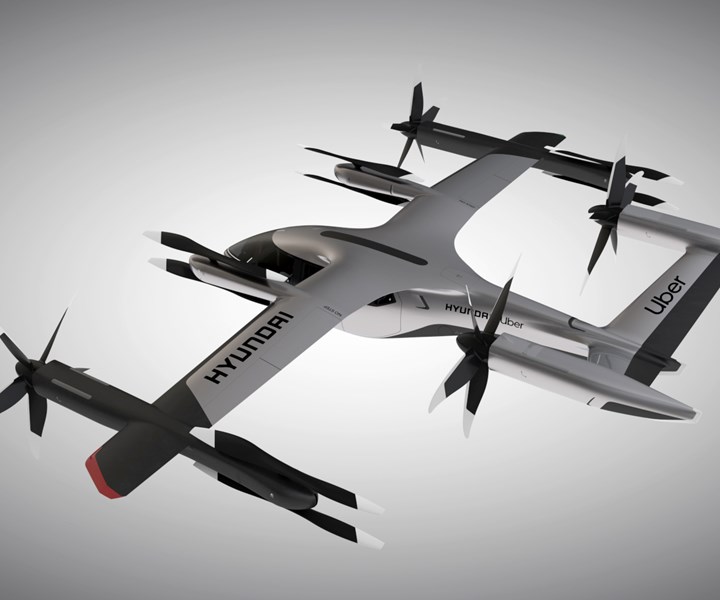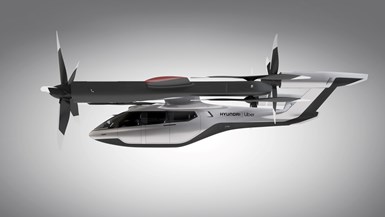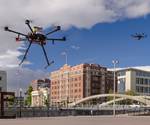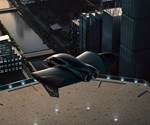Hyundai Motor Co., Uber unveil air taxi model
At the Consumer Electronics Show (CES), the companies announced an aerial ridesharing partnership and a new eVTOL design.

Source | Hyundai Motor Co. and Uber Elevate
On Jan. 6 at the Consumer Electronics Show (CES, Las Vegas, Nev., U.S.), rideshare company Uber (San Francisco, Calif., U.S.) and aHyundai Motor Co. (Seoul, South Korea) unveiled a full-scale air taxi concept and announced a new partnership to develop air taxis for use in a planned future aerial rideshare network.
Hyundai is the first automotive company to join the Uber Elevate initiative, with plans to bring its automotive-scale manufacturing capability and a track record of mass-producing electric vehicles. The air vehicle concept Hyundai released at CES was created in part through Uber’s open design process, a NASA-inspired approach that jump-starts innovation by publicly releasing vehicle design concepts so any company can use them to innovate their air taxi models and engineering technologies.

Source | Hyundai Motor Co. and Uber Elevate
Through this partnership, Hyundai will produce and deploy air vehicles, and Uber will provide airspace support services, connections to ground transportation and customer interfaces through an aerial ride share network. Both parties are collaborating on infrastructure concepts to support take-off and landing for this new class of vehicles.
Hyundai has worked with Uber Elevate to develop the S-A1 personal air vehicle (PAV) model, which is intended to optimize electric vertical take-off and landing (eVTOL) aircraft for aerial ridesharing purposes.
According to the companies, the S-A1 model unveiled at CES:
- is designed for a cruising speed up to 180 miles per hour (290 kilometers per hour), a cruising altitude of around 1,000-2,000 feet (300-600 meters) above ground, and to fly trips up to 60 miles (100 kilometers);
- will be 100% electric, utilizing distributed electric propulsion and during peak hours will require about five to seven minutes for recharging;
- utilizes distributed electric propulsion, powering multiple rotors and propellers around the airframe to increase safety by decreasing any single point of failure;
- is designed to take off vertically, transition to wing-borne lift in cruise, and then transition back to vertical flight to land;
- will be piloted initially, but over time will become autonomous; and
- is designed with a four-passenger cabin.
“Our vision of urban air mobility (UAM) will transform the concept of urban transportation,” says Jaiwon Shin, executive vice president and head of Hyundai’s Urban Air Mobility Division. “We expect UAM to vitalize urban communities and provide more quality time to people. We are confident that Uber Elevate is the right partner to make this innovative product readily available to as many customers as possible.”
“Hyundai is our first vehicle partner with experience of manufacturing passenger cars on a global scale. We believe Hyundai has the potential to build Uber Air vehicles at rates unseen in the current aerospace industry, producing high quality, reliable aircraft at high volumes to drive down passenger costs per trip. Combining Hyundai’s manufacturing muscle with Uber’s technology platform represents a giant leap forward for launching a vibrant air taxi network in the coming years,” says Eric Allison, head of Uber Elevate.
Related Content
-
Recycling hydrogen tanks to produce automotive structural components
Voith Composites and partners develop recycling solutions for hydrogen storage tanks and manufacturing methods to produce automotive parts from the recycled materials.
-
Plant tour: Joby Aviation, Marina, Calif., U.S.
As the advanced air mobility market begins to take shape, market leader Joby Aviation works to industrialize composites manufacturing for its first-generation, composites-intensive, all-electric air taxi.
-
Automotive chassis components lighten up with composites
Composite and hybrid components reduce mass, increase functionality on electric and conventional passenger vehicles.

.jpg;width=70;height=70;mode=crop)












.jpg;maxWidth=300;quality=90)

